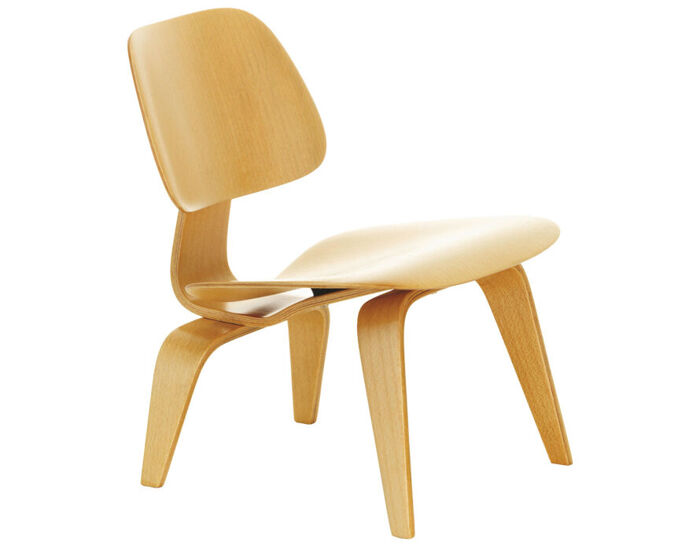miniature eames lcw
Design Charles & Ray Eames, 1945
1/6 miniature scale model
Made in Poland by Vitra
For over two decades, the Vitra Design Museum has been making miniature replicas of milestones in furniture design. The Miniatures Collection encapsulates the entire history of industrial furniture design - moving from Historicism and Art Nouveau to the New Objectivity of Bauhaus and Radical Design, and from Postmodernism all the way up to the present day. Exactly one sixth of the size of the historical originals, the chairs are all true to scale and precisely recreate the smallest details of construction, material and color. The high standard of authenticity even extends to the natural grain of the wood, the reproduction of screws and the elaborate handicraft techniques involved. This has made the miniatures into popular collector's items as well as ideal illustrative material for universities, design schools and architects.
In 1940, Charles Eames and Eero Saarinen developed a chair with a novel plywood seat molded into a three-dimensional form for a competition sponsored by the New York Museum of Modern Art. However, it was not possible to produce the chair commercially, due to inadequate technical methods. It was seldom possible to press the plywood into a three-dimensional form without it breaking or splitting. During the following years, Charles and Ray Eames concentrated their efforts on developing a new method.
The plywood chairs DCW (Dining Chair Wood) and LCW (Lounge Chair Wood) are the result of this long-term experimentation. In 1945, Charles and Ray Eames returned to the idea of a seating shell made out of molded plywood; however the results were unsatisfying. They dispensed with the multifunctional shell and divided the seat and back into separate, freely articulated elements connected by a spine (frame). Each element has a clearly defined function, which it fulfills optimally with a minimum amount of material. Shock mounts (rubber disks bonded onto the wooden surface) connect the seat and back with the frame, which exists in wood or metal and in two different heights, either as a dining chair or lounge chair.
Each Vitra miniature is true to the original in construction and materials, and reduced in size on a scale of 1:6. Each miniature is packaged in a wooden box, accompanied by an informational booklet. Production notes: Each of the delicate objects are made by hand; on average, each miniature requires five hours of careful manual work. Ongoing quality control ensures that every miniature corresponds to its larger original in terms of finishing, details and materials.
4.5" h | 3.5" w | 4" d
1/6 miniature scale model
Made in Poland by Vitra
For over two decades, the Vitra Design Museum has been making miniature replicas of milestones in furniture design. The Miniatures Collection encapsulates the entire history of industrial furniture design - moving from Historicism and Art Nouveau to the New Objectivity of Bauhaus and Radical Design, and from Postmodernism all the way up to the present day. Exactly one sixth of the size of the historical originals, the chairs are all true to scale and precisely recreate the smallest details of construction, material and color. The high standard of authenticity even extends to the natural grain of the wood, the reproduction of screws and the elaborate handicraft techniques involved. This has made the miniatures into popular collector's items as well as ideal illustrative material for universities, design schools and architects.
In 1940, Charles Eames and Eero Saarinen developed a chair with a novel plywood seat molded into a three-dimensional form for a competition sponsored by the New York Museum of Modern Art. However, it was not possible to produce the chair commercially, due to inadequate technical methods. It was seldom possible to press the plywood into a three-dimensional form without it breaking or splitting. During the following years, Charles and Ray Eames concentrated their efforts on developing a new method.
The plywood chairs DCW (Dining Chair Wood) and LCW (Lounge Chair Wood) are the result of this long-term experimentation. In 1945, Charles and Ray Eames returned to the idea of a seating shell made out of molded plywood; however the results were unsatisfying. They dispensed with the multifunctional shell and divided the seat and back into separate, freely articulated elements connected by a spine (frame). Each element has a clearly defined function, which it fulfills optimally with a minimum amount of material. Shock mounts (rubber disks bonded onto the wooden surface) connect the seat and back with the frame, which exists in wood or metal and in two different heights, either as a dining chair or lounge chair.
Each Vitra miniature is true to the original in construction and materials, and reduced in size on a scale of 1:6. Each miniature is packaged in a wooden box, accompanied by an informational booklet. Production notes: Each of the delicate objects are made by hand; on average, each miniature requires five hours of careful manual work. Ongoing quality control ensures that every miniature corresponds to its larger original in terms of finishing, details and materials.
4.5" h | 3.5" w | 4" d
Eames
The primary need of the human being was an essential component of every design for Eames. They believed a design to be successful when it benefited the greatest number of people.
Vitra is a Swiss company dedicated to improving the quality of life through the power of design. A central goal of Vitra is sustainable development. Trendy styling is avoided in favor of classic pieces that can be used for decades.












 write a review now
write a review now
